|
WHAT THE TOURS WERE
From 1925 to 1931 was held annually "The National Air Tour for the Edsel B. Ford Reliability Trophy." As the name implies, the Tours were organized by the Ford Motor Company to show the air-minded (and NOT air-minded) public that air travel was safe, and that contemporary aviation technologies -- airframes, engines, flight planning, navigation, punctuality-- were at a state of development and reliability for practical use by the general citizenry.
It was the Golden Age of Aviation: the common people still lacked the confidence to fly. The Tours covered thousands of miles around the continental United States, took several weeks to complete and attracted thousands of spectators. They generated public interest and helped soften the public's hesitation to fly by demonstrating aviation as something other than aerial stunt shows and military shows of force. Below is a photo-postcard printed by the Experimental Aircraft Association (EAA) that shows the start of the 1930 Tour at the Ford Airplane Factory in Dearborn, MI.
Postcard, Ford Reliability Tour Start, Dearborn, MI, 1930 (Source: EAA)
 |
Tour itineraries varied each year. The Davis-Monthan Airfield played a role
in the fourth, 1928, National Air Tour.
The itinerary that year was almost a circumnavigation of the United States (the map, above is from Forden reference available at the National Air Tours link at left, page 66). Because Tucson was part of the Tour, this Web page presents the context of the Tour that brought it through Arizona.
The Tour blasted through Tucson July 10-11, 1928. It was the 11th stop on the Tour. Most
of the aircraft landed and are logged in the Register during a few hours near noon on Tuesday the
10th. They remained overnight at Tucson and continued the next day westbound to Yuma, AZ and San Diego, CA. We are fortunate to have moving picture footage of Tour activities at Tucson July 10th (see the link in the left sidebar). The film gives a solid feeling of what it was like to fly and marshal aircraft at the individual stops along the way.
Another illustration of Tour dynamics occurred in 2003, when a Tour was organized and flown with vintage aircraft. The contemporary Tour is discussed at the National Air Tours link at left. A quick backgrounder on the 2003 Tour is at the link.
THE VISION FOR THIS WEB PAGE.
As far as I can tell, no where else on the Web is there a synthesis of the 1928 Tour that includes multiple candid images of people and airplanes participating in the Tour at each of the 35 scheduled stops (if anyone can refute this belief, please let me KNOW). This page aspires to do just that: to show specifically what it was like on the ground and in the air at Dearborn, MI during the mid-morning at the start of the Tour, followed by sets of images and anecdotes that illustrate the experience of being among aircraft and people at the rest of the 34 stops along the way.
*** TO THAT END, I MAKE THE FOLLOWING CHALLENGE TO SITE VISITORS. If you have or know of and would like to share personal collections of photographs or memorabilia from any ot the 1928 Tour stops, please let me KNOW. Like the collections posted below, I'll craft yours into this page with full credit to contributors. ***
I realize this could take several years to accomplish, but the journey begins with this step.
THE ITINERARY FOR THE 1928 TOUR
The table below, compiled from the Forden book in the REFERENCES, is the cumulative itinerary of 35 stops for the 1928 Tour. I have highlighted the stops for which photographs and anecdotes are exhibited below. Use the links to explore the itinerary. If you would like to contribute photographs or information to this page, please CONTACT me if you can fill in any of the other cities.
DATE |
CITY & AIRPORT NAME |
MILES |
Saturday |
Dearborn, Ford |
Start |
June 30 |
Indianapolis, Speedway |
236 |
|
St. Louis, Lambert |
235 |
July 2 |
Springfield, Municipal |
184 |
|
Wichita, Municipal |
203 |
July 3 |
Tulsa, Municipal |
131 |
July 6 |
Fort Worth, Meacham |
327 |
July 7 |
Waco, Rich |
88 |
July 8 |
San Antonio, Winburn |
170 |
July 9 |
Marfa, Army |
340 |
|
El Paso, Fort Bliss |
171 |
July 10 |
Tucson, Municipal |
263 |
July 11 |
Yuma, Fly |
213 |
|
San Diego, Mahoney |
136 |
July 12 |
Los Angeles, Mines |
113 |
July 14 |
Fresno, Municipal |
242 |
|
San Francisco, Mills |
150 |
July 16 |
Corning, Woodson |
165 |
|
Medford, Newell Barber |
169 |
|
Portland, Swan Island |
219 |
July 18 |
Tacoma, Speedway |
112 |
| July 19 |
Vancouver, WA |
|
| |
Pasco, WA |
|
|
Spokane, Felts |
418 |
July 20 |
Missoula, Municipal |
236 |
July 21 |
Great Falls, Vance |
211 |
July 22 |
Froid, Schnitzler |
326 |
|
Minot, Municipal |
146 |
July 23 |
Fargo, Hector |
228 |
July 24 |
St. Paul, Municipal (Holman) |
218 |
July 26 |
Wausau, Alexander |
169 |
|
Milwaukee, Cudahy |
155 |
July 27 |
Chicago Municipal (now Midway) |
80 |
July 28 |
Battle Creek, Kellogg |
150 |
|
Dearborn, Ford |
100 |
|
TOTAL |
6,304 |
WHO WERE THE WINNERS IN 1928?
Everyone who competed in any of the Tours through the years was a winner. Specific to the 1928 event, the table below, again compiled from the Forden book in the REFERENCES, lists the ultimate finishers of the Tour as of July 28th back at Dearborn. I have highlighted in bold the 14 pilots and aircraft who landed at Tucson and signed the Davis-Monthan Airfield Register on the day the Tour landed. I have linked those with their biographies and airplane technographies I have written for dmairfield.org. A couple of others we know were at Tucson, because they appear in the motion picture film linked from the left sidebar. A few others, like John Wood and Charlie Meyers, signed the Register at other times, but not as part of the Tour.
PILOT |
REG. NO. |
AIRPLANE TYPE |
PASSENGERS |
Wood, John P. |
5633 |
Waco |
Frank Clewers |
Hawks, Frank M |
3443 |
Ford |
Clausen & Carlson |
Page, Randolph G. |
5889 |
Stinson |
Christensen & Leisy |
Meyers, Charles W. |
6528 |
Waco |
Tom Colby, Baldwin |
Stinson, Edward A. |
5900 |
Stinson |
Soule, Stone, Porter, Day, Stinson (“4 passengers”) |
Lowers, George C. |
6580 |
Stinson |
None |
Henley, Al |
5547 |
Ryan |
Johns & Fedell |
Brock, William S. |
6503 |
Bellanca |
(Achler, E.F.), Mrs. Brock & Others |
Breese, Vance |
5553 |
Ryan |
Guinther & Hurst |
Meister, Louis B. |
5860 |
Buhl |
Dunn, Harry |
Cantwell, Robert C. |
4097 |
Lockheed |
Cooper, Acre & Leonard |
Pears, R.W. |
5574 |
Fairchild |
LaViolette & Nevill |
Kelly, J. Nelson |
3562 |
Travel Air |
William Stockert |
Haldeman, George W. |
4050 |
Bellanca |
Sterling, Haute & Lupole |
Aavang, Melvin |
6097 |
Swallow |
C.W. Helm |
Graham, A. W. |
5861 |
Buhl |
R. Nesbitt |
Levy, D.P. |
5084 |
Stearman |
Short & Innes |
Clevenger, Cloyd P. |
6505 |
Alexander Eaglerock |
McInaney (“4 passengers”) |
Atkinson, L.H. “Jack” |
5878 |
Monocoupe |
Bennett, Phylis |
Cleveland, E.W. “Pop” |
1159 |
Ryan |
Wallace, Sagel, (Nesbitt, R.) |
Beard, M.G. |
3132 |
Waco |
None |
Peck, George H. |
4739 |
Travel Air |
Smith |
Robertson, Dan. R. |
5049 |
Curtiss Robin |
Elmer C. Daughtrey |
Omlie, Phoebe F. |
5877 |
Monocoupe |
Mrs. Stinson |
Howard, Ben O. |
5891 |
Alexander Eaglerock |
Free |
Breene, R.G. |
?? |
Douglas O-2 |
Collins, Ray (Tour Referee, not a competitor) |
AT THE START: DEARBORN, MICHIGAN
Ford Airport
Forden captured the spirit of adventure for the participants in the Tour when he stated, "And so the 1928 air tour flyers need not think of themselves as heroes, setting out for California. It was just a fine chance to see the country, for many their first look at cowboys and Indians and desert cactus, orange groves, real live movie stars and other splendors they'd never heard of: Mt. Shasta, and Mt. Hood, the Blackfoot River and The Danes of the Mighty Columbia." And so they climbed into their cockpits, strapped in and took off!
Below, are wonderfully sharp photographs shared with us by site visitor Paul Kankula. Mr. Kankula's father, Nick, was a Ford Motor Company employee who was present at the start of the 1928 Tour at the "new" (established 1925) Ford Airport at Dearborn, MI. The history and demise of the Ford Airport is shown at the link. Another set of a dozen photographs are concatenated at the end of Mr. Kankula's set and can be seen by clicking on the link.
Mr. Kankula's photos are spectacular in that they show the mid-morning hustle on June 30, 1928 as festivities were initiated with the first departure as described by Forden, "Saturday, June 30, was "Air Olympics Day" at Ford Airport: an air show by Army ships, a model airplane contest and the 22nd Annual James Gordon Bennett Balloon Race.... Phoebe Omlie was first to take off, as befitted the first lady pilot in any air tour, and at nine o'clock her Monocoupe went pop-pop-popping bravely away into the cloudy sky, toward Indianapolis...." If you're like me, as you study these images, you can hear the engines, smell the oil and taste the dust!
The engines, oil and dust were started with the wave of a flag. Below, official Tour starter Edsel Ford holds the white flag he used to wave the participants on their way in 1928. There is a number of motion picture sequences at the link, which show Edsel Ford with his flag at other Tours (1925, 26, etc.). But there is no motion footage that I could find specifically for 1928 that would put some motion around the photo below. Note the well-dressed Golden Age pilot with helmet, goggles, leather jacket, jodhpurs and boots.
Edsel Ford, Official Starter, 1928 Edsel Ford Reliability Tour, June 30, 1928 (Source: Kankula)
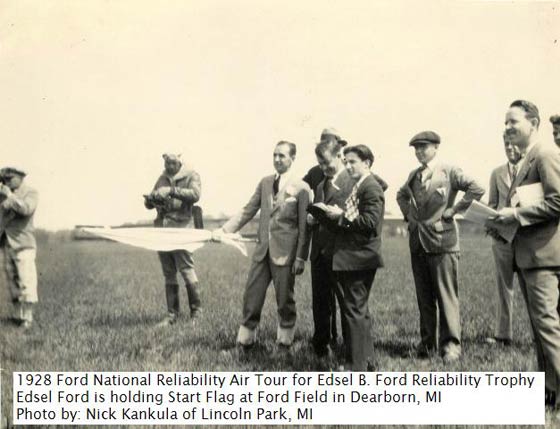 |
I'll exhibit Mr. Kankula's aircraft images roughly in the order of final finish as listed in the table above. All the Tour aircraft were photographed by his father. There are some gaps. First, is the big Ford Trimotor NC3443 flown by pilot Frank Hawks. Hawks is one of the Tour pilots who did not sign the Register at Tucson. However, we know he was there because we can see NC3443 on the ground at Tucson in the moving picture film linked from the left sidebar.
Mr. Kankula provides us with two views of NC3443. Please direct your browser to the links for Hawks and the airplane for further information and photographs. Below, we see the airplane with engines running and someone standing at the open passenger door.
Ford Trimotor, NC3443 on the Ground at Dearborn, MI, June 30, 1928 (Source: Kankula)
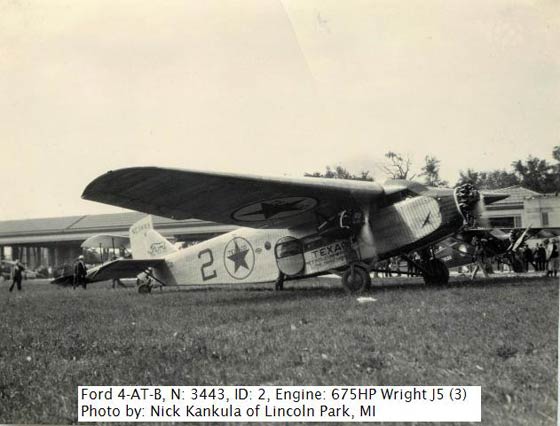 |
Below, perhaps taxiing for departure. The Ford NC3443 took second place overall in the Tour. This video link shows the end of the tour and highlights NC3443 and Frank Hawks.
Ford Trimotor, NC3443 on the Ground at Dearborn, MI, June 30, 1928 (Source: Kankula)
.jpg) |
Below, the Stinson, NC5889 of third place pilot Randolph G. Page. With the tail up, this looks like the take-off run.
Stinson NC5889 on the Ground at Dearborn, MI, June 30, 1928 (Source: Kankula)
 |
Next, the 4th place entry, Waco NC6528 flown by Charles W. Meyers. Register pilot Tom Colby was Meyers' passenger and owner of this airplane.
Waco NC6528 on the Ground at Dearborn, MI, June 30, 1928 (Source: Kankula)
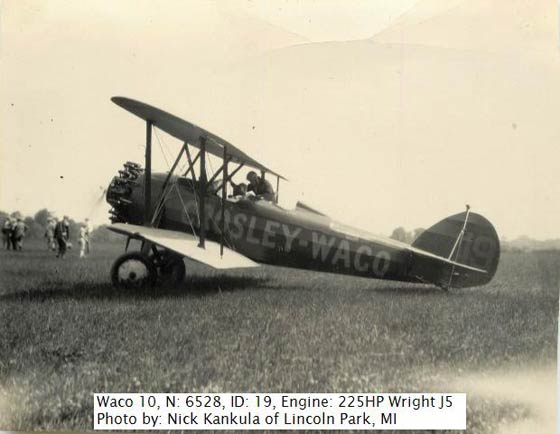 |
Below, the big Stinson, NC5900 flown by Eddie Stinson. Stinson placed 5th in the Tour.
Stinson NC5900 on the Ground at Dearborn, MI, June 30, 1928 (Source: Kankula)
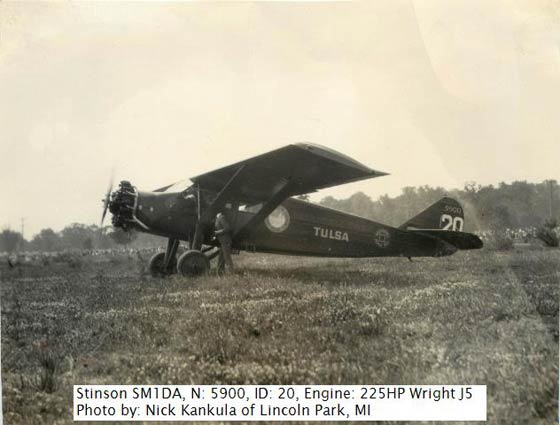 |
Next is the Stinson NC6580 flown by George C. Lowers. They placed 6th.
Stinson NC6580 on the Ground at Dearborn, MI, June 30, 1928 (Source: Kankula)
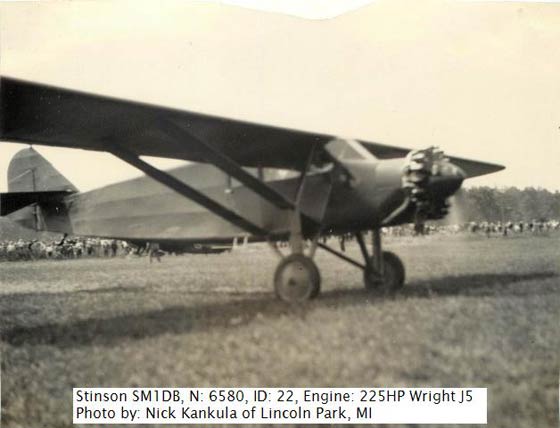 |
Below, pilot Al Henly in the Ryan NC5547 placed 7th overall.
Ryan NC5547 on the Ground at Dearborn, MI, June 30, 1928 (Source: Kankula)
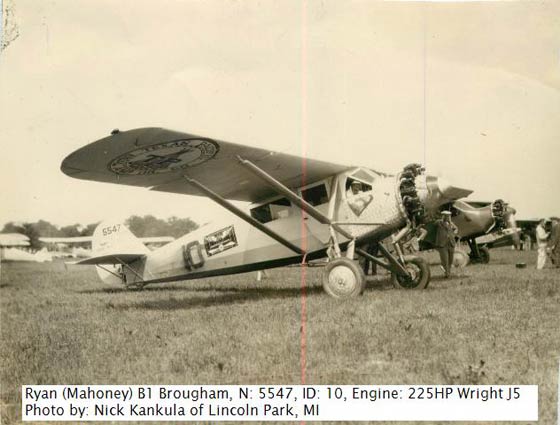 |
Eighth place was taken by William S. Brock in the Bellanca NC6503. Below, two photos of 6503.
Bellanca NC6503 on the Ground at Dearborn, MI, June 30, 1928 (Source: Kankula)
 |
The engine is running in this second view.
Bellanca NC6503 on the Ground at Dearborn, MI, June 30, 1928 (Source: Kankula)
 |
Eleventh place belonged to Robert Cantwell in the Lockheed Vega NC4097. Below, two images of this aircraft on the ground at Dearborn. It wore Tour #23. The logo on the fuselage is that of the Richfield Oil Company.
Lockheed Vega NC4097 on the Ground at Dearborn, MI, June 30, 1928 (Source: Kankula)
 |
However, the Tour number is not attached to the airplane in the photo below, even though it looks like it is preparing to depart Dearborn. Compare the image of NC4097 farther below taken at the first stop, Indianapolis, IN. The Tour number is resting on the ground. seemingly awaiting attachement.
Lockheed Vega NC4097 on the Ground at Dearborn, MI, June 30, 1928 (Source: Kankula)
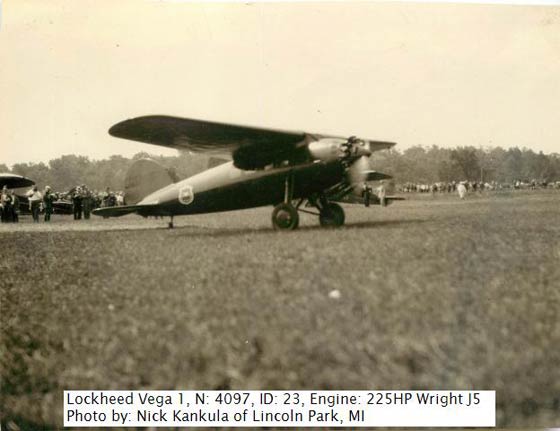 |
R.W. Pears and the Fairchild NC5574 captured 12th place. Below, the airplane has its tail up on the take-off roll. This airplane is visible in the motion picture film of the landing at Tucson, AZ. Look about 50 seconds into the film and you will see it with its wings folded back.
Fairchild NC5574 on the Ground at Dearborn, MI, June 30, 1928 (Source: Kankula)
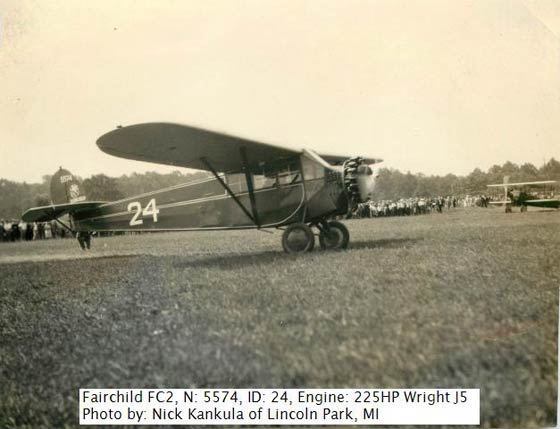 |
Lucky 13th place was captured by J. Nelson Kelly in the Travel Air NC3562. This airplane was equipped with a Caminez engine by Fairchild. It was a four-cylinder model, which was plagued with problems. Forden states, "The little cam engine developed a massive torque far in excess of its conservative 125 horsepower rating and drove a propeller ten feet long. And this oversize prop, turning at one-half engine speed, whipped around in great, hammering blows like a giant club, cracking and ripping itself to pieces while its vibration flung off into space any engine parts not securely fastened on. The violent torque twisted the airplane structure too.... And the engine ran hot...."
Travel Air NC3562 on the Ground at Dearborn, MI, June 30, 1928 (Source: Kankula)
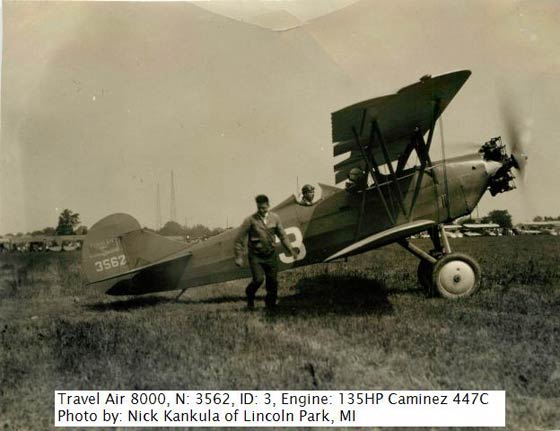 |
There was not one, but two Tour aircraft running the Caminez engine. The Waco NC3132, below was the other. Through the persistence of the Fairchild staff, both planes and engines finished the Tour. But that was the end of the Caminez engine line of products.
The Swallow, NC6097, placed 15th with Melvin Aavang and passenger Clarence Helm aboard.
Swallow NC6097 on the Ground at Dearborn, MI, June 30, 1928 (Source: Kankula)
 |
Alger Graham and the Buhl Airster NC5661 were 16th.
Buhl NC5861 on the Ground at Dearborn, MI, June 30, 1928 (Source: Kankula)
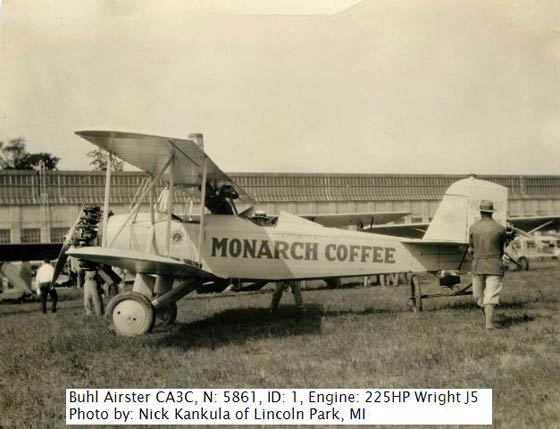 |
The Monarch Coffee Buhl and Phoebe Omlie are shown in a motion picture at the link. The footage was probably shot at the end of the Tour back in Dearborn.
Next, Cloyd Clevenger flying Alexander Eaglerock NC6505 placed 18th.
Alexander Eaglerock NC6505 on the Ground at Dearborn, MI, June 30, 1928 (Source: Kankula)
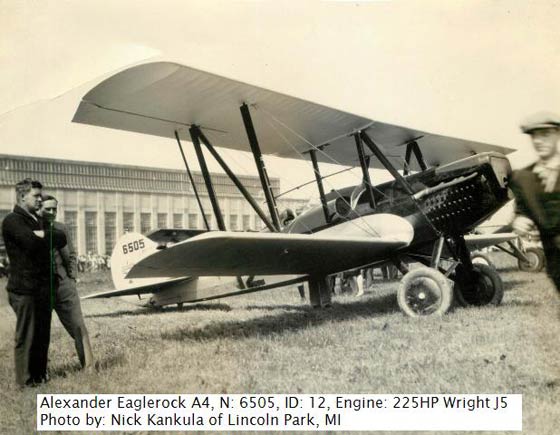 |
L.H. "Jack" Atkinson and his Monocoupe NC5878 placed 19th overall. Note the sandbags used to chock the airplane at Dearborn.
Monocoupe NC5878 on the Ground at Dearborn, MI, June 30, 1928 (Source: Kankula)
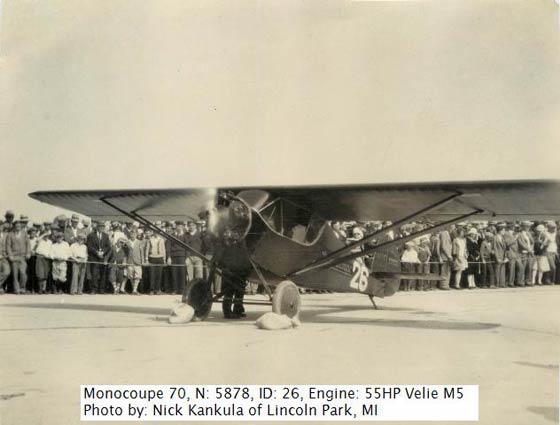 |
E.W. "Pop" Cleveland placed 20th flying his Ryan B-1 Brougham, NC1159. Two photographs follow.
Ryan NC1159 on the Ground at Dearborn, MI, June 30, 1928 (Source: Kankula)
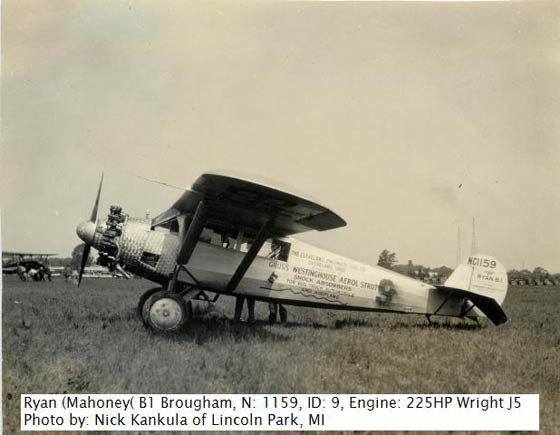 |
The second is during the takeoff run.
Ryan NC1159 on the Ground at Dearborn, MI, June 30, 1928 (Source: Kankula)
 |
M. Gould Beard and Waco NC3132 captured 21st place. Like Travel Air NC3562, above, this airplane is powered by the same Fairchild Caminez engine with all its problems. Notice the "X" prefix.
Waco NC3132 on the Ground at Dearborn, MI, June 30, 1928 (Source: Kankula)
 |
This appears to be the departure roll.
Waco NC3132 on the Ground at Dearborn, MI, June 30, 1928 (Source: Kankula)
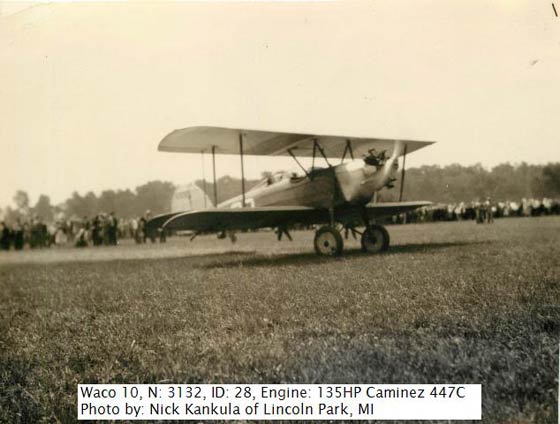 |
George Peck with his Travel Air NC4739 took 22nd place. Neither Peck nor his Travel Air are signed in the Register. Berry Brothers manufactured coatings for automobiles, boats and airplanes. See Register pilot Tom Colby for additonal information about Berry Brothers, including color charts for their aviation products.
Travel Air NC4739 on the Ground at Dearborn, MI, June 30, 1928 (Source: Kankula)
 |
Phoebe Fairgrave Omlie and her Monocoupe NC5877 captured 24th place. She did well, considering she suffered an accident at Marfa, TX.
Monocoupe NC5877 on the Ground at Dearborn, MI, June 30, 1928 (Source: Kankula)
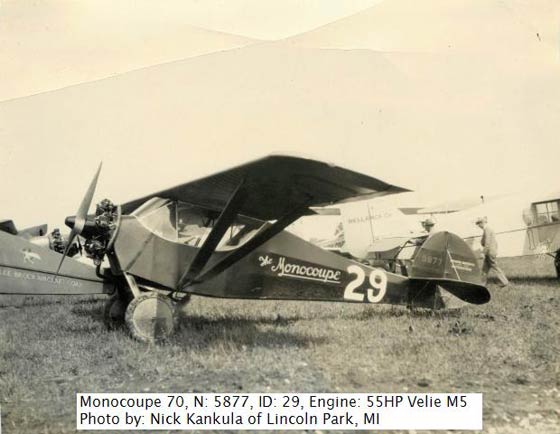 |
Below is the takeoff run.
Monocoupe NC5877 on the Ground at Dearborn, MI, June 30, 1928 (Source: Kankula)
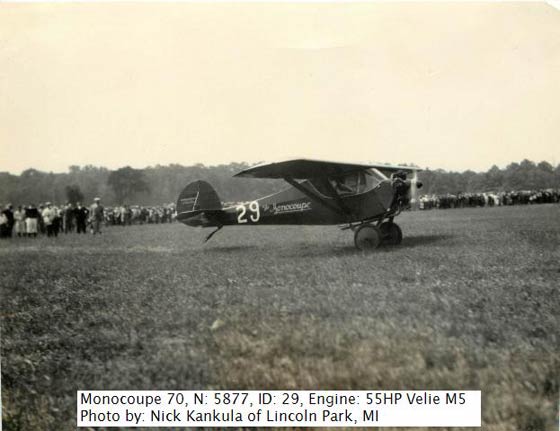 |
Finally, two views a Ryan Brougham NC3648 that was not a part of the Tour so far as I can determine. Another photo is at the link. However, it is a Register airplane landing at Tucson Wednesday, July 25, 1928 at 6:10 PM. It was flown by Ace Bragunier. He carried a single passenger indentified as G.E. Flaherty (not among any of the names tabulated by Forden). Based in Los Angeles, CA they were westbound from Detroit, MI to Los Angeles.
Ryan Brougham NC3648 on the Ground at Dearborn, MI, June 30, 1928 (Source: Kankula)
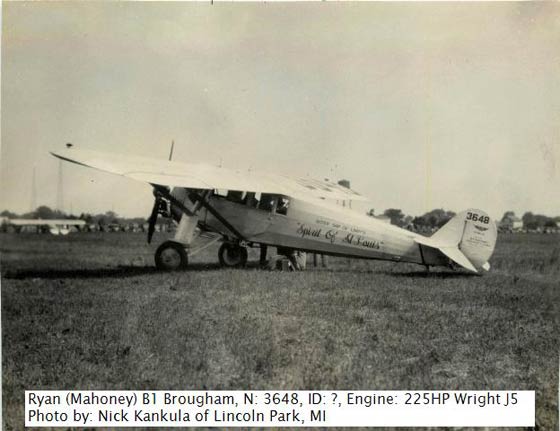 |
Given the juxtaposition of dates, June 30th at Dearborn and July 25th at Tucson, one could conjecture that the Ryan followed along with the Tour for a while, then took care of some other business (or ran into problems) and came through Tucson two weeks after the Tour passed through (the Tour was already into the eastbound home stretch in Minnesota by the 25th). In the absence of photos of it at other Tour stops (it is not visible in any of the Indianapolis photos following), or Bragunier's pilot log book, it remains conjecture.
Ryan Brougham NC3648 on the Ground at Dearborn, MI, June 30, 1928 (Source: Kankula)
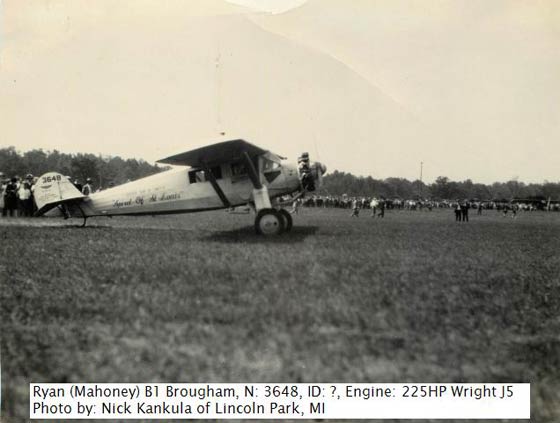 |
After all the airplanes took off and left Dearborn for Indianapolis, Forden described the James Gordon Bennett Balloon Race as follows, "There were twelve balloons [count carefully and you can see all twelve in the photograph below] with all their paraphernalia spread over one end of the field. Three were American entries, three were German, two French, and one each, from Denmark, Argentina, Belgium and Switzerland. And as soon as the air tour planes were out of the way they'd all be off and riding the wind to somewhere else."
Below are four images of balloons and baskets rising late in the morning on Monday, June 30th. In this first photo, magnification of the original image shows the Argentinian entry at far left with the Danish entry next to it. Other details include numerous skimmer straw hats, adults and children sitting in the grass, and period automobiles. A tent appears at right center. The woman at right illustrates clothing of 1928: straight, patterned shift dress with clutch hat and purse. Does anyone RECOGNIZE the woman or the boy?
Fleet of Balloons, 1928 National Air Tour, Dearborn, MI, June 30th (Source: Kankula)
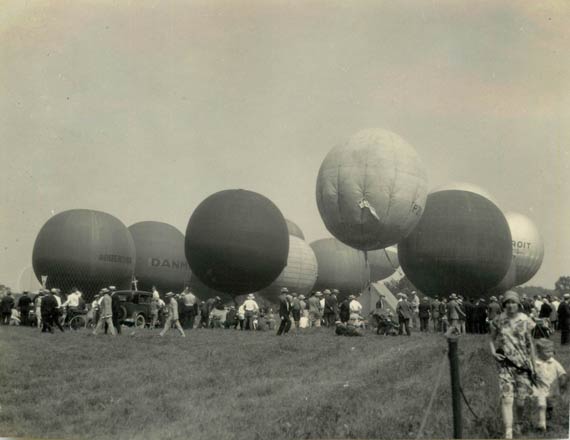 |
Below, the entry by the People's Outfitting Company. The company was a Detroit department store, now closed.
Fleet of Balloons, 1928 National Air Tour, Dearborn, MI, June 30th (Source: Kankula)
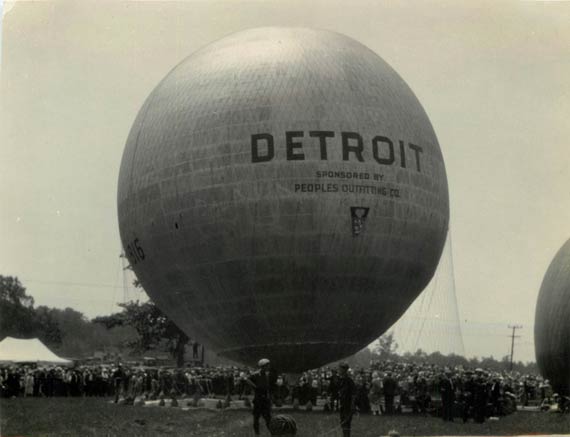 |
Below, the U.S. Army is represented and aloft. Contributor Kankula says about the balloons, "I think that they are probably filled with Hydrogen, but it could be Helium. I'm told that gas cost for filling one of these balloons, would probably have cost around $8,000 - that's a lot of money for a short trip."
Fleet of Balloons, 1928 National Air Tour, Dearborn, MI, June 30th (Source: Kankula)
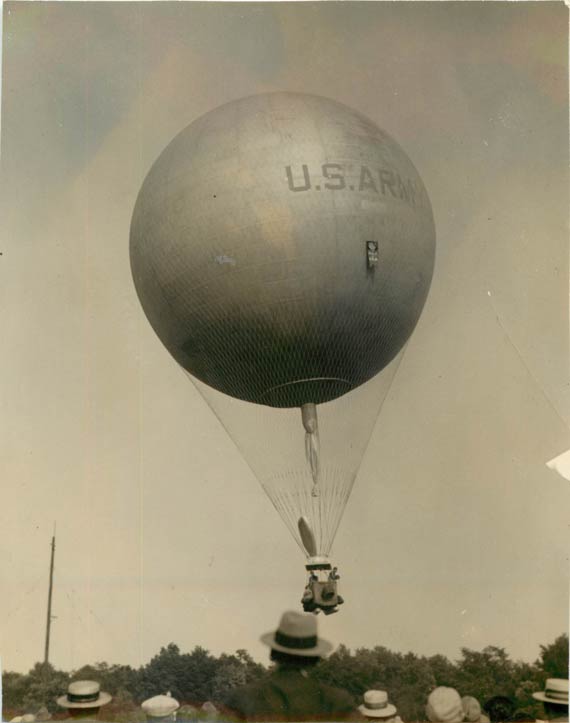 |
The photograph below captures the rising anticipation as the 22nd Annual James Gordon Bennett Balloon Race got underway...
Fleet of Balloons, 1928 National Air Tour, Dearborn, MI, June 30th (Source: Kankula)
 |
Another dozen Dearborn photographs follow, courtesy of Tim Kalina (cited, right sidebar). First is a photograph of Edsel Ford with his father, Henry, standing in the background adjusting his necktie. The license plate date is 1928 on what appears to be a Model A Ford Sedan with running boards and a shiny, nickel-plated bumper..
Edsel Ford (L), June 30, 1928 (Source: Kalina)
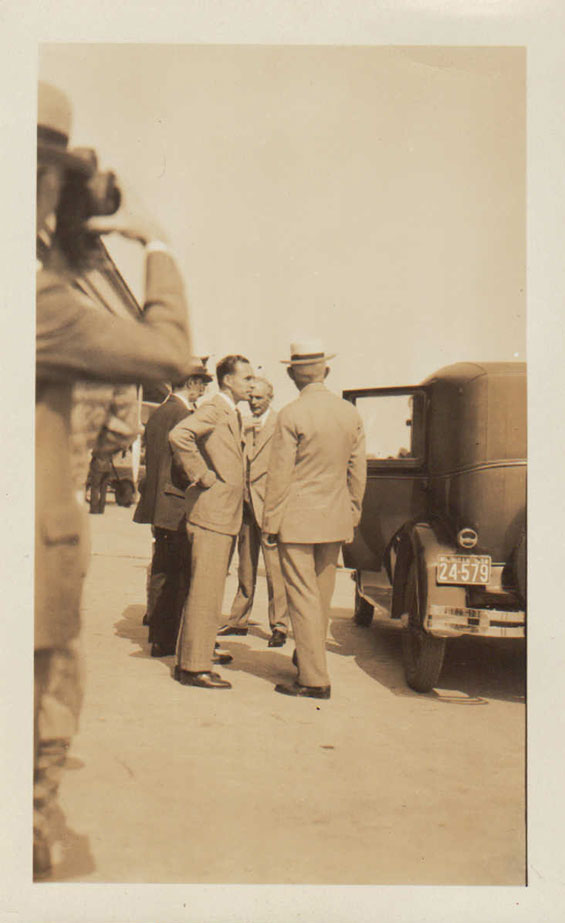 |
Below is a National Guard Curtiss O-11 Falcon, 27-98 (not a Register Airplane). This airplane was assigned to the Air National Guard and ultimately converted to a model XO-11. It also was sent to Wright Field, Dayton, OH and became a project plane assigned the number P487. I could find no evidence in this REFERENCE, Chapter 4, that this Curtiss accompanied the Tour. It might have just been on the ground the same day the Tour departed, or flew just a short distance at the onset of the Tour as a military bon voyage.
Curtiss O-11 Falcon, 27-98 (Source: Kalina)
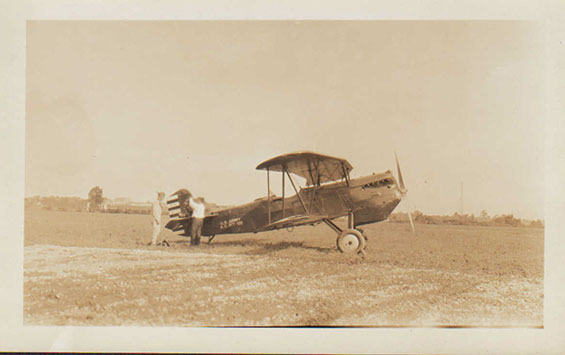 |
Below is the Stinson SM-2, NC5889, S/N 1002 (not a Register airplane), flown by Randolph Page. Page and this airplane eventually placed 3rd in the Tour. They were assigned Tour number 21. The airplane wore Stewart Aircraft Company livery (Cleveland, OH). It is being fueled by a tanker, mostly hidden at right, using a hydraulic pump.
Stinson SM-2, NC5889, S/N 1002 (Source: Kalina)
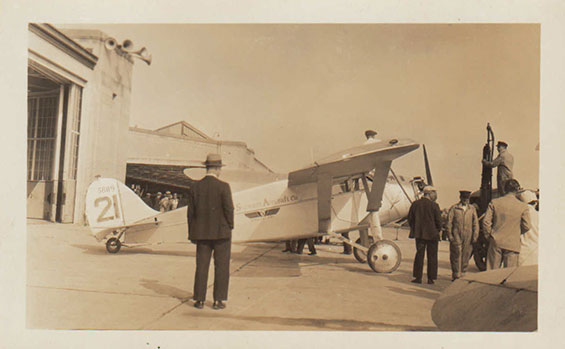 |
Below is the Curtiss Robin NX5049, S/N G-1 flown by Dan Robertson. They placed 23rd.
Curtiss Robin NX5049 (Source: Kalina)
 |
Below, a busy ramp scene in preparation for departure. Many formally-dressed men and women showed up for the event, not only at Dearborn, but at all stops along the way. In the original photograph the only recognizable registration number is of the Buhl NC6503 at right.
Ramp Scene, Dearborn, MI, June 30, 1928 (Source: Kalina)
 |
Below is Ryan B-1 Brougham NC5553, S/N 118, Tour number 16. It was flown by Vance Breese to 9th place.
Ryan B-1 Brougham NC5553, S/N 118 (Source: Kalina)
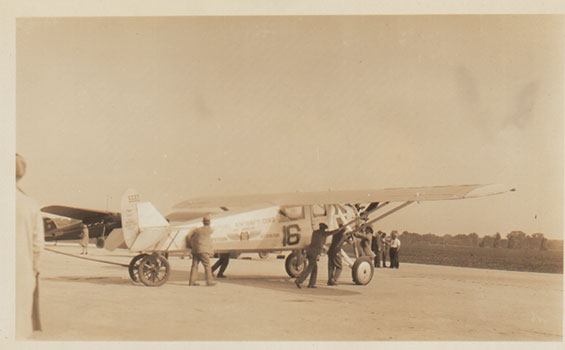 |
Next, another view of NC5553 with the tail skid guide wheels removed. The airplane was owned by the Mutual Aircraft Corporation, Los Angeles and wore the company's livery on the side of the fuselage.
Ryan B-1 Brougham NC5553, S/N 118 (Source: Kalina)
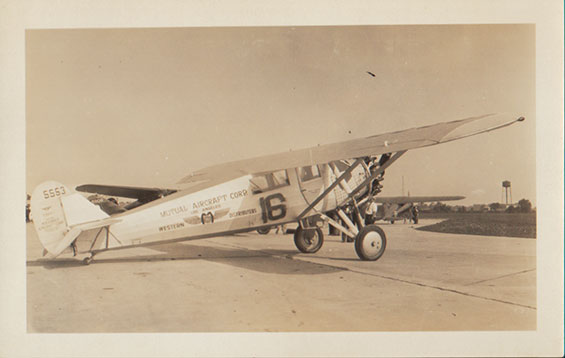 |
Below, a Ford pickup truck drives toward a Ford Airport hangar. Windsock and flag show it to be a relatively calm day.
A Ford Pickup Truck on the Ramp at Ford Airport, Dearborn, MI, June 30, 1928 (Source: Kalina)
 |
Below, an unidentified biplane sitting on the ramp unattended. It is not clear if it was a Tour airplane.
Unidentified Biplane, Dearborn, MI, June 30, 1928 (Source: Kalina)
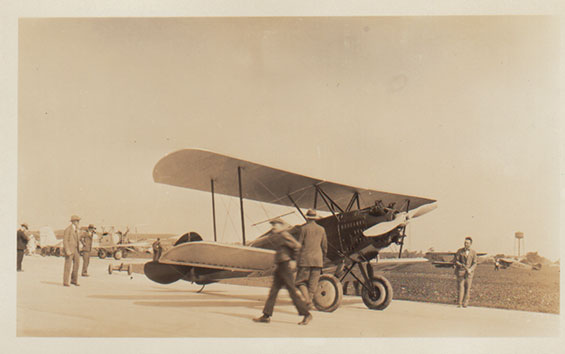 |
Following is Ford 4-AT-A NC1879, S/N 4-AT-5. This Ford is not a Register airplane, and neither did it compete or accompany the Tour. It was apparently just at the airport that day. It served for the Detroit-Cleveland Airline, which was operated by Stout Air Services, Inc. . This airplane had a long history as a transport craft, finally being sold into Mexico in August, 1944 and suffering a crash at Ometepec December 5, 1947.
Ford 4-AT-A NC1879, S/N 4-AT-5 (Source: Kalina)
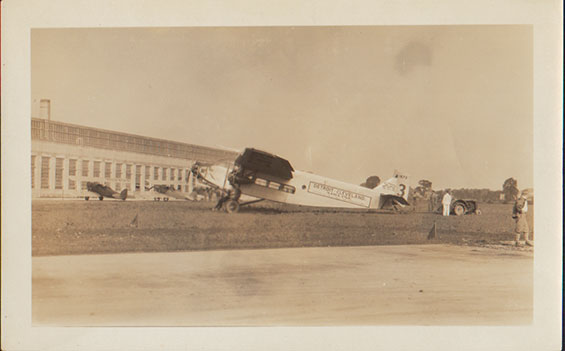 |
Below the Lockheed 1 Vega NC3625, S/N 3. Like 1879, above, this airplane was not a Register airplane and, according to this REFERENCE, Chapter 4, it did not compete in the Tour.
Lockheed 1 Vega NC3625, S/N 3 (Source: Kalina)
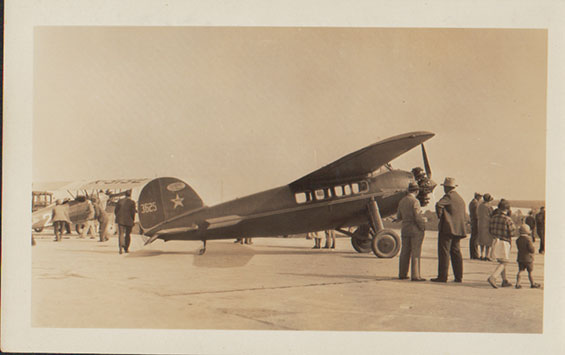 |
Below is Buhl CA-3 NC5861, S/N 27. It was flown by Alger Graham wearing Tour number 7. They earned 16th place in the Tour.
Buhl CA-3 NC5861, S/N 27 (Source: Kalina)
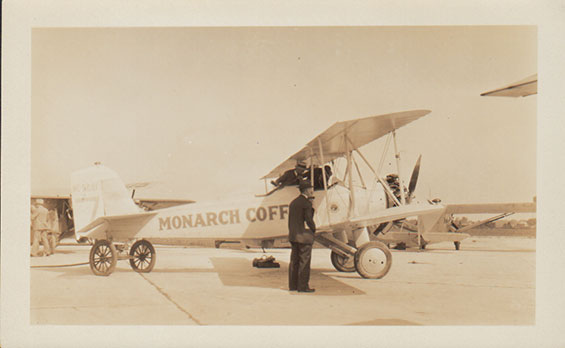 |
Although not visible in the photograph below, we know this Ford 4-AT-A is NC2492, S/N 4-AT-6, operated by the Standard Oil Company. "Stanolind" was painted on the fuselage, which, at the time was a brand sector of Standard Oil. Like a couple of the aircraft, above, this airplane was not a Register airplane and, according to this REFERENCE, Chapter 4, it did not compete in the Tour. Manufactured May 18, 1927, NC2492 was destroyed in a crash at San Marco, TX, February 8,1930.
Ford 4-AT-A, NC2492, S/N 4-AT-6 (Source: Kalina)
 |
BACK TO TOP
Think about this. The photographs you will see below that were taken at Indianapolis were snapped just a few hours after the ones you saw above. Indeed, we have a few hours of Golden Age time captured on the Web! Acquisition and Posting of Dearborn Photographs, in accordance with notes in the right sidebar.
---o0o---
---o0o--- ---o0o---
BACK TO TOP
AT THE FIRST STOP: INDIANAPOLIS, INDIANA
Indianapolis Speedway
The next landing by all the aircraft was at Indianapolis, IN. The father of site visitor J.W. Tretter photographed the Tour as it landed at Indianapolis on June 30, 1928. This was the first stop on the Tour after departing Dearborn, MI (Tucson was the 11th stop). "Speedway" meant just that: the airplanes landed on the infield of the Indanapolis Speedway rather than at one of the local airports. Ms. Tretter says about Speedway, it was located, "... about 4900 W. 16th Street, ... Eddie Rickenbacker and a group had bought the Speedway in 1927.... The infield was used previously in 1909 for an aviation meet and balloon races." Given that the Speedway property was over 300 acres back then, the infield could easily handle all the Tour aircraft.
A few newspapers covered the preparations for, and arrival of, the Tour at Indianapolis. Below, courtesy of Ms. Tretter, from the Indianapolis Star, a morning paper. Note that the article states that a Mohawk monoplane flown by Dr. Joseph A. Mowicki was entered in the Tour. Neither plane nor pilot started the Tour (see the second article, below). There were a couple of non-starts and a couple of aircraft added at the last minute.
Indianapolis Star, June 30, 1928 (Source: Tretter)
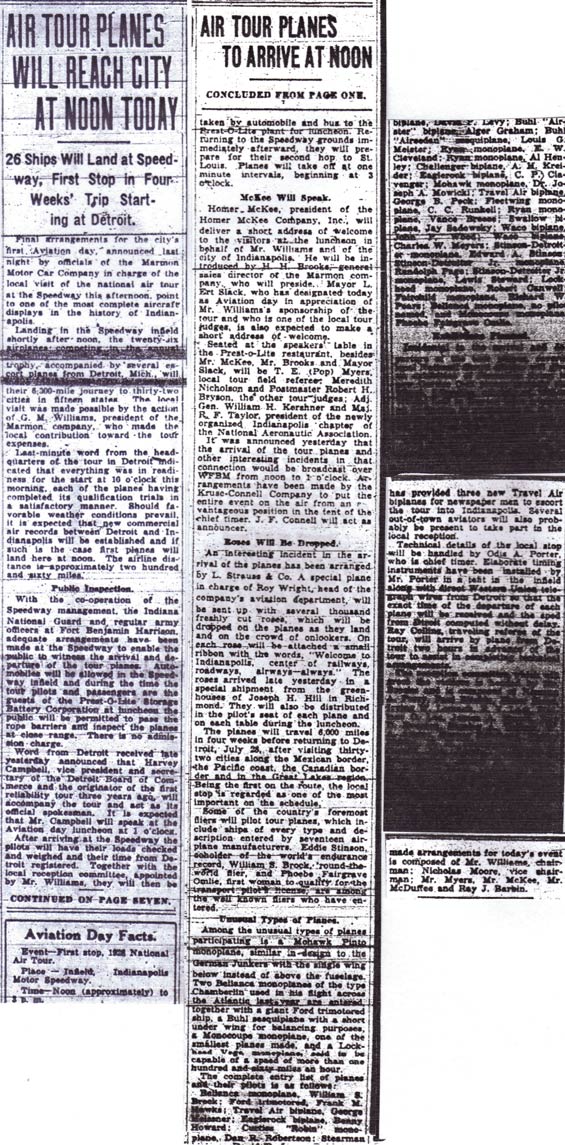 |
Ms. Tretter provides the following text that represents the parts of the image in the right-most column that can' t be read.
Exhibitions Planned
"Incidental to the arrival and departure of the tour planes, several local National Guard officers will give an exhibition of formation flying in new Curtiss O-11 planes recently obtained. Likewise, officials at Wilbur Wright field in Dayton have accepted an invitation to participate in the reception and will send two or more of the army’s newest fast pursuit planes to give an aerial exhibition.
"The Hoosier Airport, headed by Harold C. Brooks and Bob Shanks, has provided three new Travel Air biplanes for newspaper men to escort the tour into Indianapolis. Several out-of-town aviators will also probably be present to take part in the local reception.
"Technical details of the local stop will be handled by Odis A. Porter, who is chief timer. Elaborate timing instruments have been installed by Mr. Porter in a tent in the infield along with direct Western Union telegraph wires from Detroit so that the exact time of the departure of each plane will be received and the speed from Detroit computed without delay. Ray Collins, traveling referee of the tour, will arrive by plane from Detroit two hours in advance of the tour to assist in completing technical arrangements.
"The reception committee which will greet the aviators is headed by Mr. Brooks and is composed of Norman A. Perry, Paul Ritchie, Elmer Stout, Irving W. Lemaux, R.V. Law, Wallace O. Lee, James A. Stuart, Ray D. Everson, Stanley A. Tullsen, W. A. Askins, Harper Ransburg, Homer McKee, H. M. Glossbrenner, E. B. Gorrell, Roy Adams, Frederick E. Schortsmeier, Joseph H. McDuffee, E. J. Rork, Lieut. Walter R. Peck, Maj. R. F. Taylor, Capt. Oliver Stout, Capt. H. Weir Cook, Lieut. Matt Carpenter, Robert Shanks and Harold C. Brooks.
"The executive committee which made arrangements for today’s events is composed of Mr. Williams, chairman; Nicholas Moore, vice-chairman; Mr. Myers, Mr. McKee, Mr. McDuffee and Ray J. Barbin."
Below, from the Star of July 1st, the report of the departure from the Speedway and the arrival at St. Louis. One thing that sometimes goes missing when you study events like this from the era of black & white films, is that there was lots of color. The writer of this article compared the Tour aircraft to, "... great tropical birds, in their coats of silver and gold, purple and orange, blue and green and scarlet...." This, combined with the shower of roses, paints a very colorful picture of the 1928 Tour at Indianapolis. Notice the misspelling of Louis Meister's name in the headline.
Indianapolis Star, July 1, 1928 (Source: Tretter)
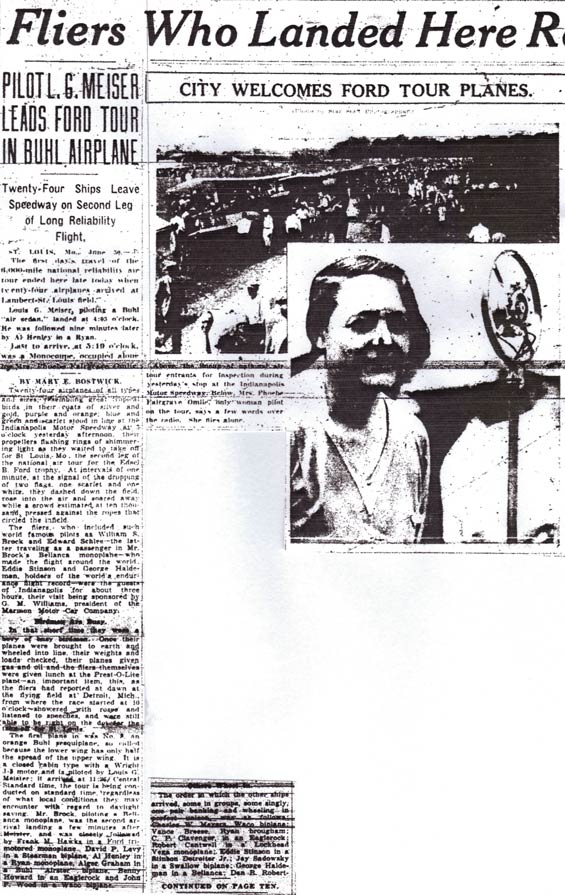 |
Below, the continuation of the article says that due to the fine weather and no admission charge to enter the Speedway infield, the crowd numbered about 10,000 to view the planes on the Tour.
Indianapolis Star, July 1, 1928, Continued(Source: Tretter)
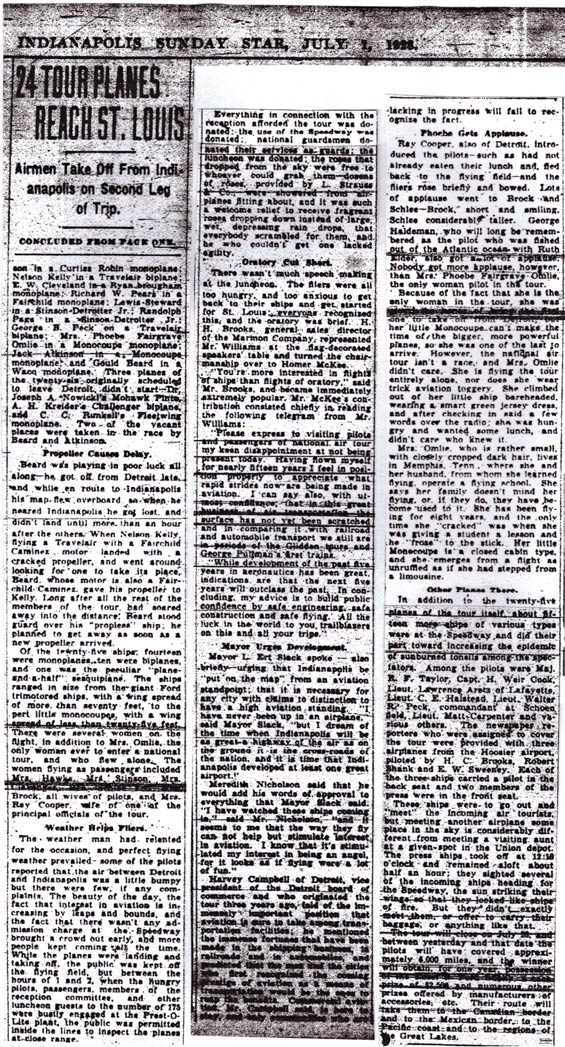 |
Tipton Tribune, May 28, 1928 (Source: Tretter)
|
Ms. Tretter says about her father's photos, "... I rescued the box of dad's photos from the attic of the bungalow I grew up in, when my mother was putting it up for sale. I don't think I really spent much time going through all that was in it until several years ago (life was just too busy). Mom didn't have any interest in them, and because they had belonged to dad who died when I was 19, I wanted them. It wasn't until I started working on my dad's family genealogy that I began to find clues here and there about his life prior to marrying my mother ...."
The news article, left, from a local newspaper of May 28, 1928, made it clear that the Tour was a big deal for Indianapolis. Hospitality at Indianapolis was sponsored by the Marmon Motor Car Company. An abbreviated itinerary is at the end of the article. Curiously, Tucson is not listed among the cities.
Logansport Pharos-Tribune, June 30, 1928 (Source: Tretter)
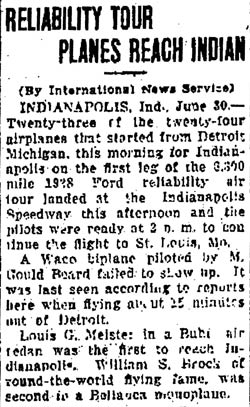 |
News article, above, from June 30, 1928, announces the arrival of the Tour to Indianapolis. First to arrive at Indianapolis was Louis Meister in NC5860; second was William Brock in NC6503.
A good Web resource for studying the history and demise of Indianapolis area-airports is found at the site named Abandoned and Little-Known Airfields. Ms. Tretter supplies photos of other Indianapolis-area airfields, which are exhibited at Indianapolis, IN.
The news article, below, further built anticipation for the Tour in Indianapolis. Note that this time Tucson is mentioned in the itinerary.
Vidette-Messenger, June 26, 1928 (Source: Tretter)
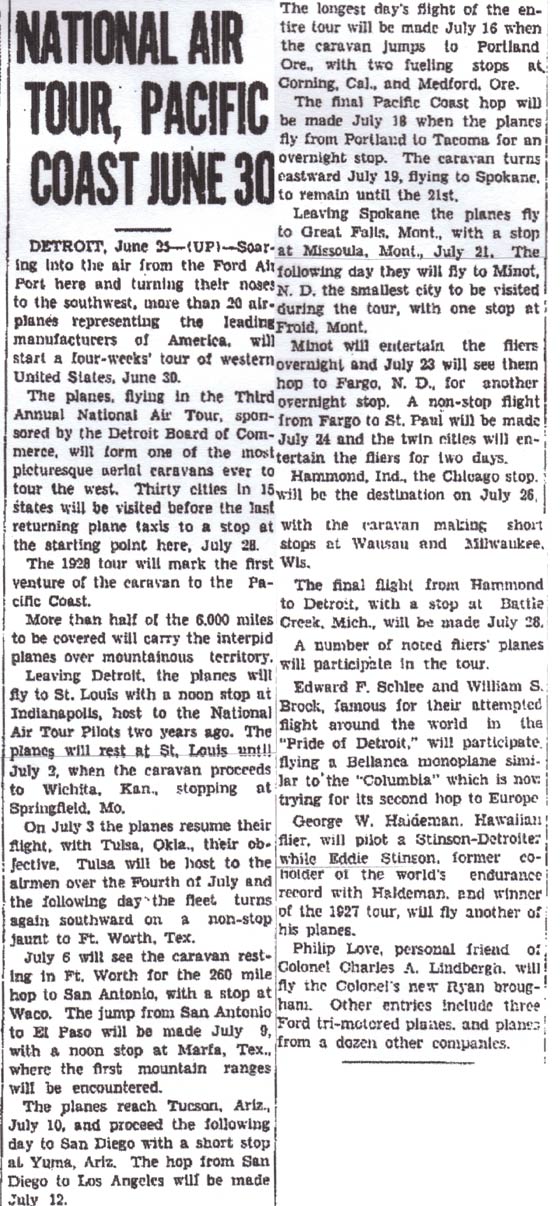 |
Below, this pleasant trove of photos is very special in that they are candid snapshots and not professional-grade portraits. From the viewpoint angles of most of these shots, we can guess that the camera was held at waist level with the viewfinder on the top with the photographer looking down to frame the scene for exposure.
Note well, none of these photographs is of Tucson or environs. However, regardless of the location, the type of activity was the same from station to station. And some, but not all, are of the same aircraft and pilots who landed at Tucson. To this last point, we are fortunate here to have several aircraft that are not signed in the Register, although it is fairly certain they did land at Tucson during the Tour. Ms. Tretter shares the following photos from her father's album.
Below, Buhl Sport Air Sedan NC5860 flown by Louis Meister. This airplane arrived first at Indianapolis and ultimately placed 10th in the Tour. Interestingly, this airplane is still registered with the FAA. According to the FAA Web site, its registration status is in question, however. Another photograph of the Buhl appears below at the Great Falls, MT stop.
NC5860, Buhl Air Sedan Model CA-C3, June 30, 1928 (Source: Tretter)
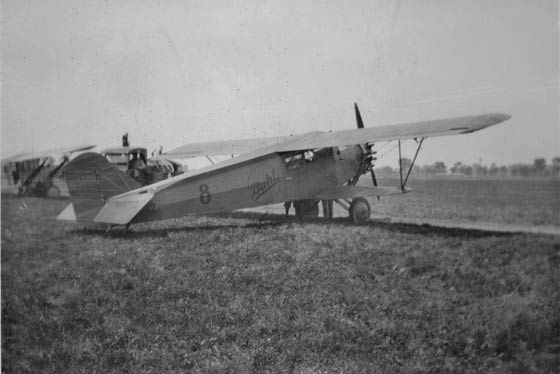 |
The next view is of the flight line at the Speedway infield. The airplanes remained on the ground for only a couple of hours. It is impossible to know if this is arrival or departure traffic.
1928 Ford Reliability Tour, Indianapolis, IN, June 30, 1928 (Source: Tretter)
 |
Two Monocoupe Model 70s competed in the Tour. Below are NC5877 (Tour #29) and NC5878 (Tour #26). Number 26 is visible at left, above, too. According to the Register, Phoebe Omlie flew 5877 to Tucson and L.K. Atkinson piloted NC5878. According to Forden's book (left sidebar) Omlie was in 5878 and Atkinson in 5877. Please direct your browser to the airplane pages, and to the section for Marfa, TX below for further discussion of the conjecture.
Monocoupe NC5878 (Foreground) and NC5877 Warming Up (Source: Tretter)
 |
Monocoupe NC5877 (Foreground) and NC5878 Warming Up (Source: Tretter)
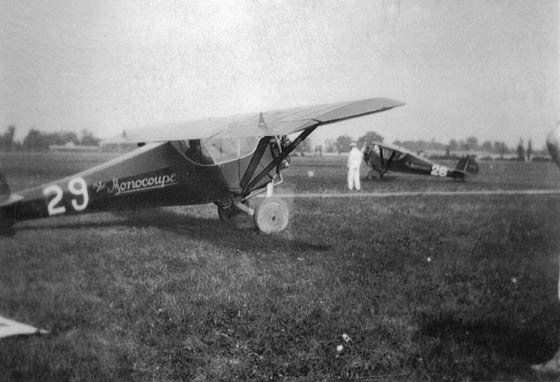 |
Below, Phoebe Omlie in front of NC5878. Her dress, we learned from the news article above, is green jersey.
Phoebe Omlie in front of NC5878, June 30, 1928 (Source: Tretter)
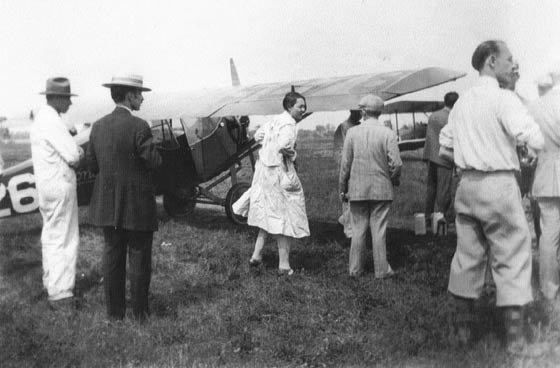 |
Below, Stearman C2B NC5084 flown by Deed Levy. This airplane placed 17th overall. While NC5084 was not signed in at Tucson during the Tour, it did sign in during May, 1930. The person below is unidentiffied, but, from the flag, he could be a volunteer starter or ground handler for the pilots and aircraft, perhaps stationed with the Indiana National Guard.
Stearman NC5084, June 30, 1928 (Source: Tretter)
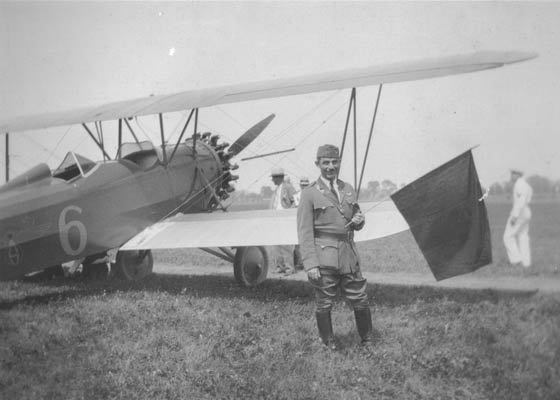 |
Below, is Bellanca NC6503 on the ground at Speedway. Please follow the airplane's link to learn about its pilot when it landed at Tucson. Behind the Bellanca is NC5084, the Stearman C2-B flown by D.P. Levy Please direct your browser to the link for the Stearman to learn that it was flown to Tucson by another pilot a couple of years later. It was destroyed in a crash circa 1937. As well, in the original image the Ford trimotor NC3443 is visible in the distance and identifiable by its race #2 on the fuselage. At the link, you can see a fine profile of NC3443 supplied by Ms. Tretter.
Bellanca CH NC6503 on the Ground at Indianapolis, IN, Ca. June 30, 1928 (Source: Tretter)
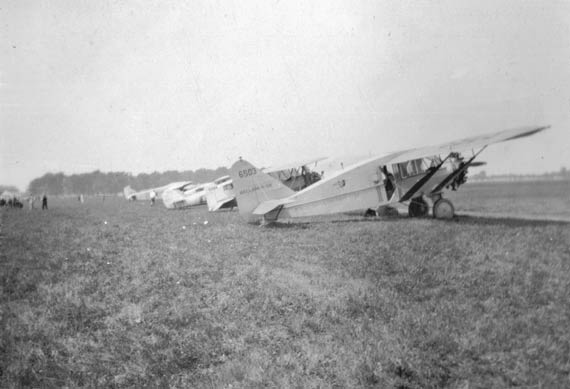 |
Below, the Richfield Oil Lockheed Vega, NC4097, flown by Register pilots Lee Schoenhair and Robert Cantwell. It wore race number 23, which can be seen lying on the ground next to the fuselage. The logo on the side is that of Richfield Oil.
Lockheed Vega NC4097 at Indianapolis, IN, June 30, 1928 (Source: Tretter)
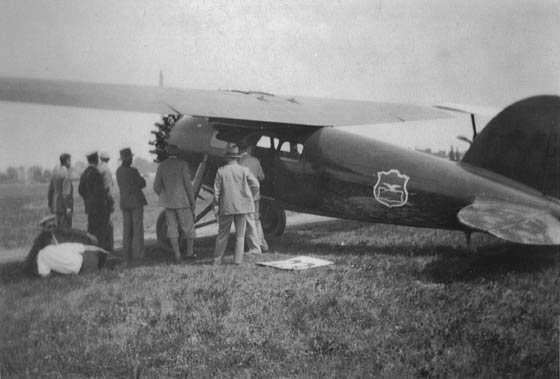 |
Below, NX5049, a Curtiss Robin, Tour #5, flown by Dan R. Robertson. Neither pilot Robertson nor NX5049 appear in the Register. It was powered by a Curtiss OX-5 of 90 HP. It placed 23rd overall in the Tour.
OX-5 Curtiss Robin, Indianapolis, IN, June 30, 1928 (Source: Tretter)
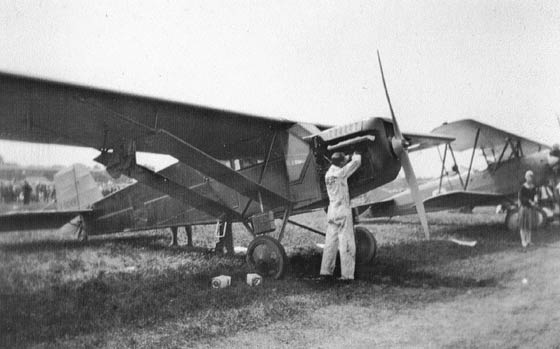 |
Below, the ultimate 3rd place winner, Stinson Jr. NC5889 (Tour #21) flown by Randolph Page. Tour #24, the Fairchild FC-2 NC5574 flown by R.W. Pears is behind #21, taxiing into the distance. The airplane at center is not identifiable (looks like it might be Meister's Buhl, see above). Like the Robin above, neither pilots Page or Pears nor NC5889 or 5574 appear in the Register.
Stinson NC5889 (Tour #21) And Others at Indianapolis, June 30, 1928 (Source: Tretter)
.jpg) |
The Tour aircraft departed Indianapolis for St. Louis, MO, the second leg of their journey on June 30th. Acquisition and Posting of Indianapolis Photographs, in accordance with notes in the right sidebar.
---o0o---
---o0o--- ---o0o---
BACK TO TOP
The following stops are waiting to be documented. IF YOU CAN HELP, PLEASE CONTACT YOUR WEBMASTER.
AT THE SECOND STOP: ST. LOUIS, MISSOURI
Lambert Field
AT THE THIRD STOP: SPRINGFIELD, MISSOURI
Springfield Municipal Airport
AT THE FOURTH STOP: WICHITA, KANSAS
Wichita Municipal Airport
AT THE FIFTH STOP: TULSA, OKLAHOMA
Tulsa Municipal Airport
AT THE SIXTH STOP: FORT WORTH, TEXAS
Meacham Field
AT THE SEVENTH STOP: WACO, TEXAS
Rich Field
AT THE EIGHTH STOP: SAN ANTONIO, TEXAS
Winburn Field
AT THE NINTH STOP: MARFA, TEXAS
Army Airfield
At Marfa, Tour participants were westbound from San Antonio, TX to El Paso, TX. Below are five views of a few of the airplanes captured by an Army photographer (who posed his friends). Thanks to Tim Kalina for pointing out the link to these photos.
First, the Bellanca NC6503 flown by William Brock. They placed 8th.
Bellanca CH NC6503, July 9, 1928 (Source: Web)
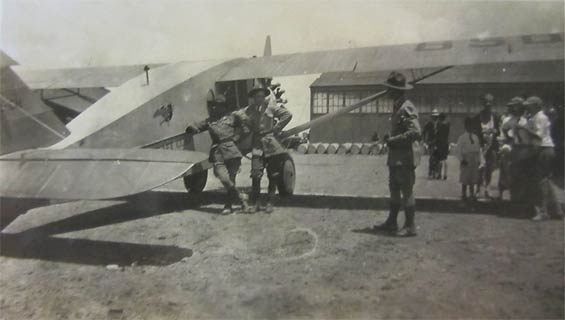 |
Next, the Stinson NC5900 flown by Eddie Stinson. They ultimately placed 5th in the Tour.
Stinson NC5900, July 9, 1928 (Source: Web)
 |
Below, the Ford NC3443 at Marfa being fueled from 5-gallon cans. At a nominal fuel capacity of 231 gallons, it would take 46 of those cans to completely fuel the airplane from empty. The Ford was flown by Frank Hawks who took 2nd place.
Ford NC3443, July 9, 1928 (Source: Web)
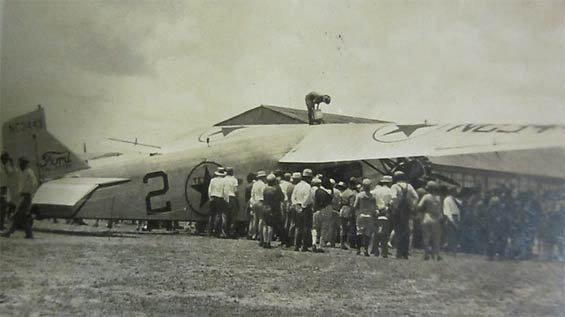 |
Below, the Monocoupe NC5878, flown by Phoebe Omlie. Her airplane had an engine of 47HP. Her Monocouple (race #26) was painted black and orange and named “Miss Memphis.” Omlie traveled alone, accompaniued by neither navigator nor mechanic. She told reporters: “If I take a mechanic, they’ll say that he flew the ship over the bad spots!” That it was flown solo by Phoebe may account for the predominance of women lookers and bystanders. She was the first woman to compete in any Air Tour.
Monocoupe NC5878, July 9, 1928 (Source: Web)
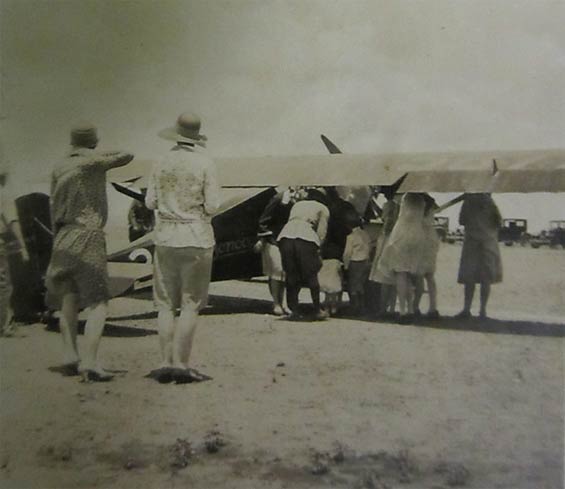 |
Phoebe ground-looped and flipped her Monocoupe at Marfa, and went down again at Laguna Beach, CA. She finished the race in 24th place.
Below, the Waco NX3132 flown by M.G. "Dan" Beard (21st place). His airplane was powered by the new Fairchild
Caminez engine. If you go to the National Air Tour link
cited in the left sidebar and download the Forden book (PDF) from that
Web site, you'll find a description of the "Cam Waco" in chapter
4 (with more information about the 1928 Tour and another
photo of pilot Beard standing next to his airplane).
Waco NX3132, July 9, 1928 (Source: Web)
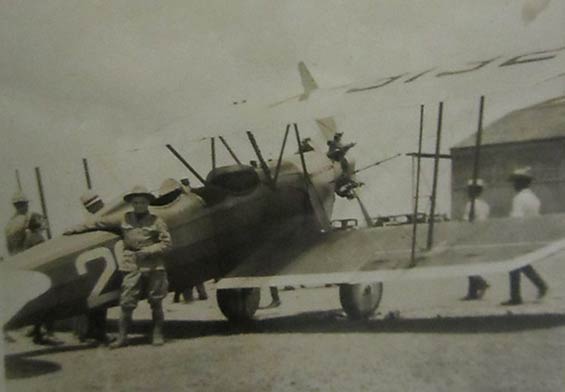 |
Acquisition and Posting of Marfa Photographs, in accordance with notes in the right sidebar.
AT THE TENTH STOP: EL PASO, TEXAS
Fort Bliss
AT STOP ELEVEN: TUCSON, ARIZONA
Davis-Monthan Airfield
WORKING ON THIS SECTION
Monarch Coffee Buhl and others shown in film
At Tucson, Tour participants were westbound on their way from El Paso, TX to Yuma, AZ before entering California and turning north. After Tucson they would make a large arc up the
west coast to Washington state, then eastward near the Canadian
border, across the midwest back to Dearborn, MI and the finish
line. Please follow this link to
see images of some of the competing aircraft on the ground
at San Diego, CA a day after their stop in Tucson.
If you look at the Register page,
none of the pilots who landed at Tucson entered times of day
in the register on the 10th except Breene at 10:20 AM and Robert Cantwell at 11:30:50 AM (to be exact!). Other times listed
on the page pretty much bracket the landings of competitors.
It was a busy day for air traffic at the Airfield, and the sense of the hustle and bustle can be seen in the movie footage linked above. On the
next Register page,
the final tour participant, L.H. "Jack" Atkinson
(near the top of the page) landed at Tucson on 7/14 at 9:30
PM. Compare the tabulation of pilots in the 1928 tour available
from the Forden link at left (pp. 84-85 of chapter 4) with the pilot signatures and aircraft
cited on the Register pages linked above.
What is significant is about our day at Tucson is that,
of 25 pilot entrants on the tour of 1928, over half (14)
signed the Davis-Monthan Airfield register. Among them Robert
Cantwell, Phoebe
Omlie, Eddie
Stinson, William
S. Brock, Al Henley, M.G.
Beard and E.W. "Pop" Cleveland.
Information about these Ford Tour airplanes is available
here: NC4097, NC5553, NC5877, NC5878, NC5900.
---o0o---
---o0o--- ---o0o---
BACK TO TOP
AT STOP TWELVE: YUMA, ARIZONA
Fly Field
AT STOP THIRTEEN: SAN DIEGO, CALIFORNIA
Mahoney Field
Buhl Airster NC5861 at San Diego at Cosgrove Collection. Also Baby Ruth and others
AT STOP FOURTEEN: LOS ANGELES, CALIFORNIA
Mines Field
AT STOP FIFTEEN: FRESNO, CALIFORNIA
Fresno Municipal
AT STOP SIXTEEN: SAN FRANCISCO, CALIFORNIA
Mills Field
AT STOP SEVENTEEN: CORNING, CALIFORNIA
Woodson Field
AT STOP EIGHTEEN: MEDFORD, OREGON
Newell Barber
AT STOP NINETEEN: PORTLAND, OREGON
Swan Island
AT STOP TWENTY: TACOMA, WASHINGTON
Speedway
AT STOP TWENTY-ONE: VANCOUVER, WASHINGTON
AT STOP TWENTY-TWO: PASCO, WASHINGTON
AT STOP TWENTY-THREE: SPOKANE, WASHINGTON
Felts Field
AT STOP TWENTY-FOUR: MISSOULA, MONTANA
Missoula Municipal
AT STOP TWENTY-FIVE: GREAT FALLS, MONTANA
Vance Field
The Tour was in Great Falls on July 21-22. Below is an image of the cover of a special commemorative booklet from Great Falls printed especially for the Air Tour stop there..
Booklet, 1928 National Air Tour, Great Falls, MT (Source: Webmaster)
 |
This 8-page booklet was printed by the local Comet Oil Company and the Texas Pacific Coal and Oil Company. It contained the Tour itinerary and dates, lists of Tour pilots and passengers, advertisements for local companies, schedule of prizes and the on-the-ground schedule at Vance Field.
Below are photographs of the Great Falls Tour stop shared with us by site visitor Tonya Crippen from her grandfather's photograph album. The first is a page from her grandfather's album that exhibits the five images that follow. Her grandfather's name was Edwin L. Crook.
1928 Tour Page From E.L. Crook's Photo Album, Ca. July, 1928 (Source: Crippen)
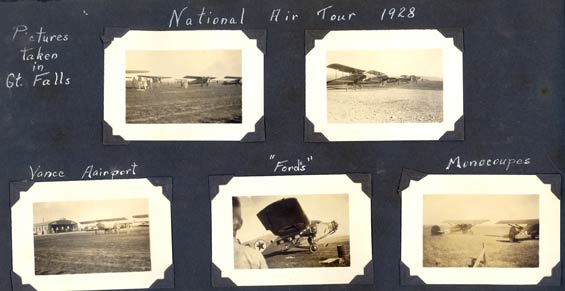 |
These photos were mounted with adhesive corner slots on the black pulp paper typical of so many photo albums of the day. Below, the photo of Vance Airport. None of the aircraft or people are recognizable in this view.
Vance Airport, Great Falls, MT, July 21, 1928 (Source: Crippen)
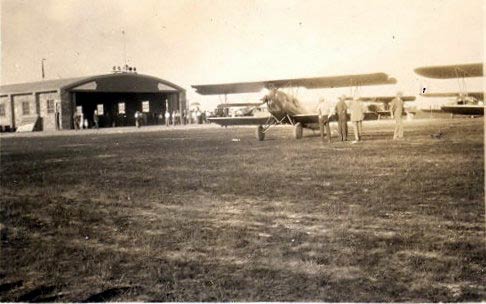 |
Next, the big Ford Trimotor (featured in the film cited in the left sidebar on this page).
The airplane is Texaco's Ford Trimotor NC3443, Tour #2. It was flown by Register pilot Frank Hawks.
Ford Trimotor, Great Falls, MT, July 21, 1928 (Source: Crippen)
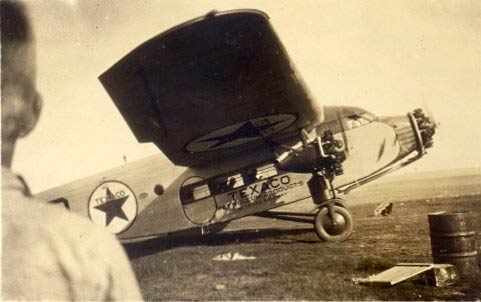 |
Two Monocoupes participated. Race number 26 was NC5878 flown by Phoebe Fairgrave Omlie. Number 29 was NC5877 flown by Jack Atkinson.
Monocoupes, Great Falls, MT, July 21, 1928 (Source: Crippen)
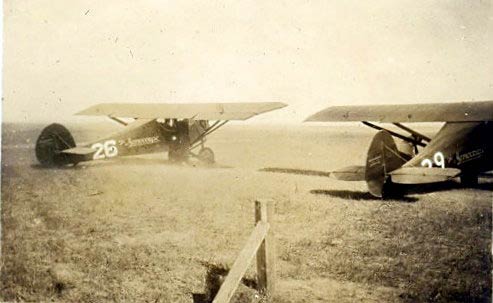 |
Below, two of the aircraft are identifiable in the next photograph. The Buhl Sport Air Sedan, NC5860, flown by Louis Meister, is in the front row center. It has distinctive sesqui-plane lower wings. The Ford Trimotor is visible behind it.
Flight Line, Great Falls, MT, July 21, 1928 (Source: Crippen)
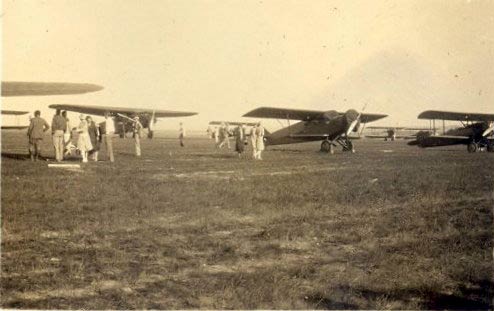 |
None of the aircraft are identifiable on this second flight line photograph, except, perhaps, for the tiny Monocoupe at center.
Flight Line, Great Falls, MT, July 21, 1928 (Source: Crippen)
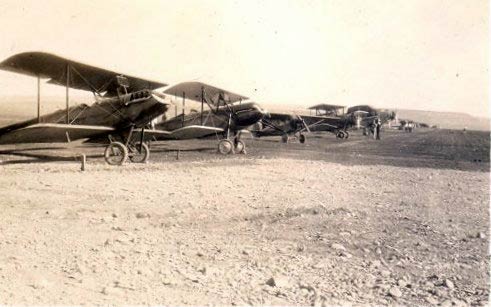 |
Acquisition and Posting of Great Falls Photographs, March, 2012.
---o0o---
---o0o--- ---o0o---
BACK TO TOP
AT STOP TWENTY-SIX: FROID, MONTANA
Schnitzler Field
AT STOP TWENTY-SEVEN: MINOT, NORTH DAKOTA
Minot Municipal
AT STOP TWENTY-EIGHT: FARGO, NORTH DAKOTA
Hector Field
AT STOP TWENTY-NINE: ST. PAUL, MINNESOTA
Holman Field
AT STOP THIRTY: WAUSAU, WISCONSIN
Alexander Field
AT STOP THIRTY-ONE: MILWAUKEE, WISCONSIN
Cudahy Field
AT STOP THIRTY-TWO: CHICAGO, ILLINOIS
Midway
AT STOP THIRTY-THREE: BATTLE CREEK, MICHIGAN
Kellogg Field
AT STOP THIRTY-FOUR: DEARBORN, MICHIGAN
Ford Airport
---o0o---
Dossier 4.2
THIS PAGE UPLOADED: 5/7/05 REVISED: 7/1/05, 02/14/06, 05/02/06, 02/18/07,
04/02/07 (movie link), 05/15/07, 10/30/08, 12/01/10, 12/05/10, 03/20/12, 09/12/16, 12/09/19
|

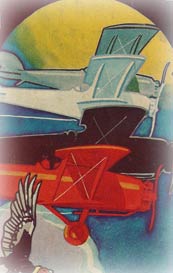
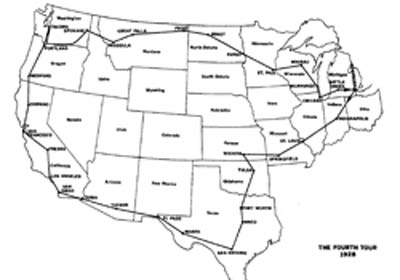



.jpg)
























































.jpg)











